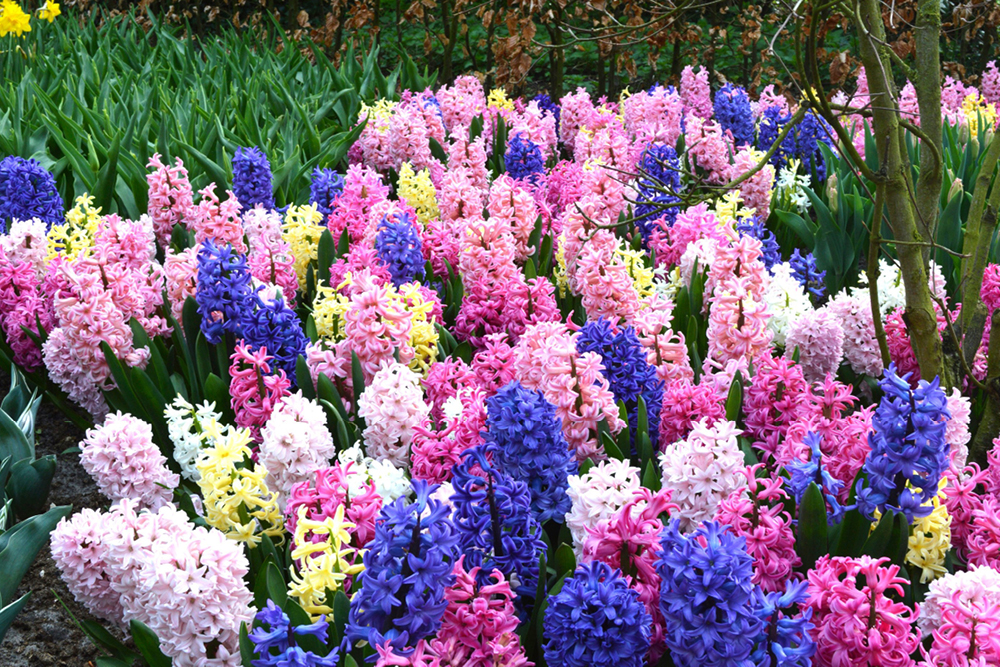The hyacinth, a flower rich in cultural and mythological heritage, is a spring emblem that captivates with its vivid colors and sweet scent.
Mythological Roots
Its story is rooted in Greek mythology, born from a tragic tale of love and loss. Apollo, the sun god, inadvertently caused the death of the youth Hyacinthus, whom he adored. In his grief, Apollo transformed Hyacinthus’ spilled blood into the hyacinth flower, bestowing upon it a lasting name and an enduring story that symbolizes the cycle of life, death, and rebirth. This mythology has imbued the hyacinth with deep symbolism: peace, commitment, and beauty. Yet, its diverse hues—purple to white—also express nuanced emotions like sorrow, jealousy, loveliness, and forgiveness. Each color offers a unique meaning, enriching the flower’s symbolism.
Other Cultural Significance
The hyacinth is steeped in cultural significance outside of its Greek mythology. In the Victorian language of flowers, flowers represented sportiveness and varying emotions based on their colors. The hyacinth is significant in religious texts and symbolizes spring and renewal during Nowruz, the Persian New Year. Its historical cultivation in the Dutch floral trade also marked it as a symbol of affluence and beauty.
Enchanting Scent
Recognized for its striking fragrance, the hyacinth is a mainstay in perfumery. Its aroma is believed to elevate moods. The flowering of hyacinths in the soft light of early to mid-spring heralds the season’s arrival. While a beacon of natural beauty, this time-honored flower harbors a hidden danger: its bulbs contain toxic substances, such as oxalic acid, which can cause various symptoms if ingested or improperly handled.
Hyacinths’ influence extends beyond gardens; they are entwined with cultural celebrations like Nowruz, the Persian New Year, which symbolizes spring’s rejuvenation. To enjoy their beauty year-round, hyacinths can be ‘forced’ to bloom indoors during winter, offering a burst of color and fragrance against the bleakness of the season. Over centuries, the hyacinth has spread globally, with botanist Carolus Linnaeus classifying it within the Asparagaceae family in the 18th century. This period saw hyacinths gain massive popularity in Europe, leading to extensive breeding and various cultivars.
Cultivation and Care
Hyacinths thrive particularly well in New Jersey’s climate, suited for USDA hardiness zones 6a to 7b. Gardeners plant bulbs in the fall to enjoy the blooms come spring, following careful practices to ensure their health and longevity. Hyacinth bulbs are planted in the fall in well-drained soil to bloom in spring, with a layer of mulch to protect them over winter. Regular watering and fertilizing are essential during their growth phase, but overwatering must be avoided. For out-of-season blooms, bulbs can be “forced” in a warm environment after a chilling period. After flowering, allow the foliage to die back naturally to reinvigorate the bulbs for the next season. Proper care, including pest and disease management, ensures these fragrant flowers thrive, particularly in hardiness zones 6a to 7b. Cultivation methods for hyacinths have evolved, with water cultivation becoming popular. They can be grown in water using a specially designed vase, which holds the bulb and allows its roots to stretch into the liquid beneath.
Today, the hyacinth stands as a cherished floral species, admired for its beauty and rich tapestry of stories and symbolism, reflecting humanity’s perpetual dance with nature and the cycles of life.

